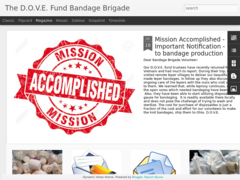patterns > The D.O.V.E. Fund Bandage Brigade

Notes
Notes
THE D.O.V.E. FUND BANDAGE BRIGADE
www.dovefund.org
www.leprosybandages.blogspot.com
****MAKING CROCHETED OR KNITTED BANDAGES FOR VIETNAMESE PEOPLE SUFFERING FROM LEPROSY**** Patterns/Instructions:
Finished Size: approximately 3 ½ to 4 inches wide by 4 feet long. If it shrinks up to be a bit smaller when washed…don’t worry that is fine. They are used to wrap everything from tiny fingers to the stumps of lost legs and feet. No two applications are the same so our bandages can vary a bit as well.
Material specifications: 100% mercerized crochet cotton or polyester – size #10 - white, cream or ecru (no irritating dyes). This is commonly called “bedspread cotton” (1 ‘ball/skein’ will usually make two bandages.)
Suggested brands include: South Maid D54, DMC Traditions, Aunt Lydia’s Classic Crochet Thread, Cro Sheen and JP Coats. You can find these online as well as at your local Wal-Mart, fabric or craft store.
Tightness: The bandages shown above are good examples of how they should look. It should be ‘medium-tight’, not strangling, but fairly close, with breathable holes If yours look Mesh-like they are too loose - please switch to a smaller crochet hook (size D) or knitting needle (size 2). These are tighter and made with smaller thread/yarn (no worsted weight) than the ones organizations used to send to India as the climate and needs are different in Vietnam.
Knitted Leprosy Bandage:
Use size 2 (2.75 mm = UK 12) knitting needles if you knit loosely or average,
Use size 3 (3.25 mm = UK 10) needles if you knit tightly.
Cast on 24 to 28 stitches so the bandage measures about 4” across.
Knit every row until bandage is desired length of 48 inches long, and then bind off.
PLEASE DON’T FORGET: Secure thread end by slipping thread through last stitch, tying a double knot, and weaving end back through stitches. A sewing needle works well to do this.
Crocheted Leprosy Bandage:
Use size D (3.00 mm = UK 11) or E (3.50 mm = UK 9) crochet hook (loose tension desirable).
Chain enough stitches to measure about 4” in width.
(I use 23 chs and an E hook, and it takes about 6 rows to equal one inch.)
Row 1: Single crochet into each chain. Chain 1 and turn.
Row 2: Single crochet into each sc across row. Ch 1 and turn. Continue to single crochet to end, chain 1 and turn. Repeat row 2 until bandage measures 48 inches long.
PLEASE DON’T FORGET: Secure thread end by pulling thread through last loop, secure with a knot and weaving the end back through the stitches. A sewing needle works well to do this.
When Completed:
AFTER you have woven the ends back into the stitches, wash the bandages, roll them and secure with a large safety pin. Put in plastic bag (several to a bag if desired), remove air, and seal.
NOTE: The bandages do NOT have to ‘perfect’, so if you are afraid yours are not “straight” enough or you dropped a stitch 5 rows before, don’t let that stop you. Relax and have fun making them.
Why handmade bandages and not gauze or store bought“?
“These leper bandages breathe better, and can be sterilized for reuse.” The people suffering from leprosy wear these bandages on their stumps as well as on sores. Gauze would wear out too fast.
The recipients recognize the time involved in making these and it is a special blessing to them that someone cares enough to take the time. Each one is cherished and gratefully accepted.
Leprosy in the world…
Many 3rd world countries like Vietnam still have victims of LEPROSY (also known as “Hansen’s Disease”). They are outcasts in society and life is not kind to them. You can help make life a little easier for them by making and donating these handmade bandages to wrap their wounds. The people are gracious and appreciative of every item.
Your bandages will be delivered direct to leprosy villages in Vietnam:
D.O.V.E. Fund (www.dovefund.org) groups return to Vietnam at least once a year and will be escorting these precious bandages to be delivered to the remote villages where victims of leprosy are in need of them.
Finished bandages:
These should be sent to me (address listed below) and I will combine them with others and get them into the next shipment to Vietnam. Please enclose in your box a sheet of paper (8 ½ x 11) with your name, address, phone and e-mail contact information (to save us postage, if you have an e-mail address).
Mailing Address & Contact Information:
Linda Stocker
The D.O.V.E. Fund Bandage Brigade
171 Mulkey Lane, Ariel, WA 98603
(sgtstocker@gmail.com) (360)231-4212
Want to help but not interested in knitting or crocheting?
• You can help by sponsoring your neighbor, friend, local civic, church or school group in their leprosy bandage campaign. Some volunteers have lots of time to donate but not the money for the thread or postage to send them to us.
• These people are literally starving! For just $15 you can provide a food packet to feed the family of someone suffering from leprosy for one month. There is also ongoing need for funds to take them medicines and start providing scholarships to their children so ultimately they will be able to help support the family.
• Monetary contributions can be made by sending a check to “The D.O.V.E. Fund” with the designation “Bandage Brigade”. Mailing address for donations is P.O. Box 350741, Toledo, Ohio 43635.
• 100% of your designated donation will be used to deliver to these unfortunate people the bandages, food and medicine they so desperately need.
The D.O.V.E. Fund is a 501(c)3 nonprofit organization and is incorporated under the laws of the state of Ohio. Contributions are tax deductible.
For an update on current activities among our growing network of volunteers, please visit the “The D.O.V.E. Fund Bandage Brigade Blog” at http://leprosybandages.blogspot.com
Website published in January 2013


